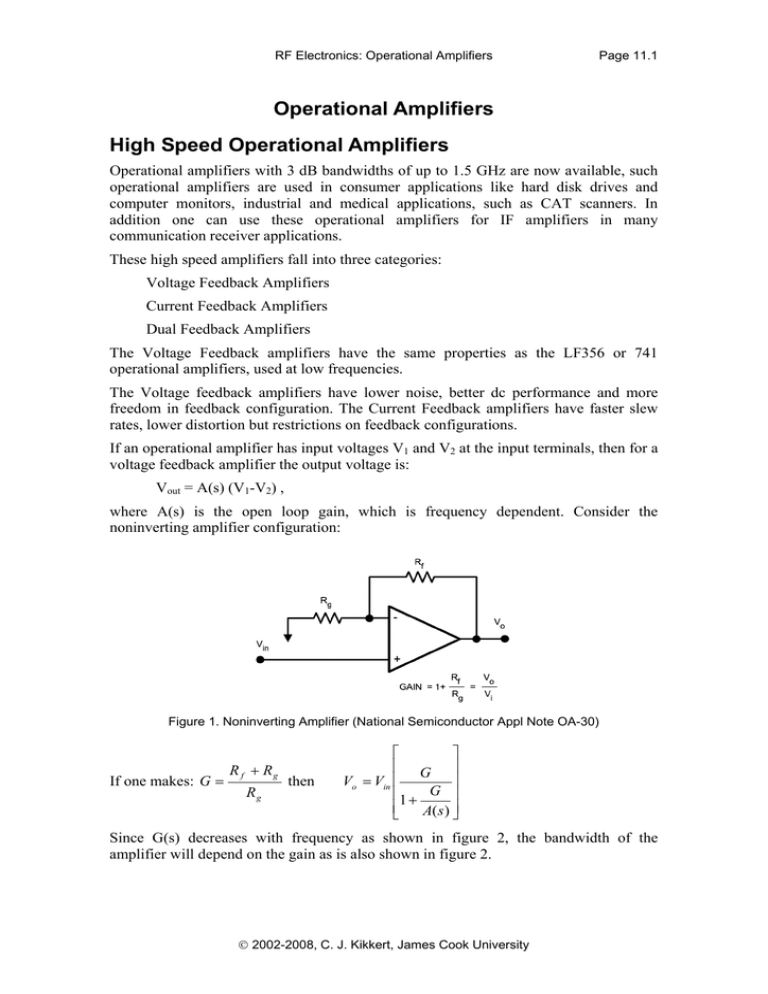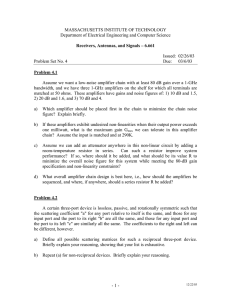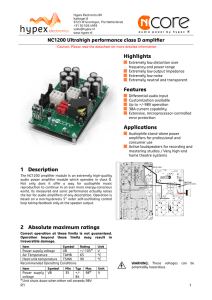Operational Amplifiers High Speed Operational Amplifiers
advertisement

RF Electronics: Operational Amplifiers Page 11.1 Operational Amplifiers High Speed Operational Amplifiers Operational amplifiers with 3 dB bandwidths of up to 1.5 GHz are now available, such operational amplifiers are used in consumer applications like hard disk drives and computer monitors, industrial and medical applications, such as CAT scanners. In addition one can use these operational amplifiers for IF amplifiers in many communication receiver applications. These high speed amplifiers fall into three categories: Voltage Feedback Amplifiers Current Feedback Amplifiers Dual Feedback Amplifiers The Voltage Feedback amplifiers have the same properties as the LF356 or 741 operational amplifiers, used at low frequencies. The Voltage feedback amplifiers have lower noise, better dc performance and more freedom in feedback configuration. The Current Feedback amplifiers have faster slew rates, lower distortion but restrictions on feedback configurations. If an operational amplifier has input voltages V1 and V2 at the input terminals, then for a voltage feedback amplifier the output voltage is: Vout = A(s) (V1-V2) , where A(s) is the open loop gain, which is frequency dependent. Consider the noninverting amplifier configuration: Figure 1. Noninverting Amplifier (National Semiconductor Appl Note OA-30) If one makes: G R f Rg Rg then G Vo Vin 1 G A( s ) Since G(s) decreases with frequency as shown in figure 2, the bandwidth of the amplifier will depend on the gain as is also shown in figure 2. 2002-2008, C. J. Kikkert, James Cook University RF Electronics: Operational Amplifiers Page 11.2 Figure 2. Open loop and Closed loop gain of Voltage Feedback Amplifier (National Semiconductor Appl Note OA-30) The Current feedback amplifier Figure 3 Current Feedback amplifier configuration (National Semiconductor Appl Note OA-30) For the inverting amplifier configuration, the equations for the amplifier are: ierror Vin Vo Vin Rf Rg Since Vo Z ( s ) I error , substituting for Ierror in the above equation after manipulation leads to: Vo Rg V Z ( s ) R f in Z ( s) The current feedback amplifier will thus have a transfer function of: G Vo Vin compared with a transfer function of : Rf 1 Z (s) G for the voltage feedback amplifier. Vo Vin 1 G A( s ) 2002-2008, C. J. Kikkert, James Cook University RF Electronics: Operational Amplifiers Where G Page 11.3 R f Rg is the ideal amplifier gain, which is the same for both amplifiers. Rg The difference is thus in the way G/A(s) and Rf/Z(s) behave with frequency. Halving both Rf and Rg will double the bandwidth and keep the gain the same for the current feedback amplifier, but not change the gain for the voltage feedback amplifier. Doubling the gain by halving Rg will halve the bandwidth of the Voltage feedback amplifier but will not change the bandwidth of the current feedback amplifier. The use of low impedances will allow current amplifiers with high bandwidths to be obtained. Current feedback amplifers have higher input currents and that makes them less suitable for integrators. There is basically no slew rate limit for the current feedback amplifier, so that much higher slew rates can be obtained. Current feedback amplifiers generally result in have a lower distortion than Voltage Feedback amplifiers, as can be seen in the table 1. Current and Voltage Feedback Amplifier Comparison Current Feedback Voltage Feedback Device LMH 6702 LMH6624 3dB Bandwidth 720 MHz 1.5 GHz Slew rate 3100 V/s 350 V/s Noise Voltage 1.83 nV/Hz 0.92 nV/Hz Noise Current 3.0 pA/Hz 2.3 pA/Hz Distortion (HD2) -79 dBc (20 MHz, 2Vpp) -63 dBc (10 MHz, 1Vpp) Distortion (HD3) -88 dBc (20 MHz, 2Vpp) -80 dBc (10 MHz, 1Vpp) Input Offset Voltage 1 mV 0.1 mV Input Offset Current 13 A 0.1 A Load Resistor test circ 100 100 Feedback Resistor test circ 237 500 Feedback Resistor range Narrow Very wide Supply Voltage 5V to 6 V 2.5 V to 6 V Supply Current 12.5 mA 12 mA Cost (US$/1000) $1.49 $1.67 Table 1. Current and Voltage Feedback performance comparison 2002-2008, C. J. Kikkert, James Cook University RF Electronics: Operational Amplifiers Page 11.4 Low Noise designs using Operational Amplifiers: The noise associated with a resistor is E NR 4kTBR Where: K T B R = Boltzman’s constant 1.38E-23 Joules/°Kelvin = Absolute temperature Kelvin = Bandwidth in Hz = Resistance in In a circuit each resistor is then associated with its own noise source which has a random noise voltage of ENR. In addition the operational amplifier produces noise which can most accurately be represented as voltage (e ni) and current noise sources (ini+ and ini-) at the inputs, as shown in figure 4. Figure 4 Noise sources in an operational amplifier configuration (National Semiconductor Appl Note OA-11) The values for e ni and for ini+ and ini- are normally obtained from manufacturers data sheets. The table 2 shows the noise performance of some low noise amplifiers from different manufacturers. The noise of operational amplifiers will rise at low frequency, as shown in figures 5 to 8, and is inversely proportional to frequency at low frequencies, due to flicker noise or 1/f noise. The corner frequency of that 1/f noise may be important in a design. For example is a microphone amplifier is required, the noise performance at less than 1 kHz is important and the LMH6622 has a better noise performance at those frequencies than the LMH6624, which has a better noise performance at higher frequencies only. 2002-2008, C. J. Kikkert, James Cook University RF Electronics: Operational Amplifiers Page 11.5 Manufacturer Part nV/sqrtHz 1/f Hz GBWP MHz VinOffset mV Texas Instruments TLE2037 2.5 50 0.1 Texas Instruments OPA2300 3 150 5 Analog Devices AD8028 4.3 190 0.9 Analog Devices AD8099 0.85 500 0.2 Analog Devices AD797 0.9 300Hz 100 Hz 110 0.025 National Instruments LMH6624 1 10kHz 1500 0.5 National Instruments LMH6622 2 1kHz 160 1.2 National Instruments LF356 100Hz 5 3 12 Table 2. Low Noise Operational Amplifiers. Figure 5. Noise of LMH6624L versus frequency Figure 6. Noise of LMH6622 versus frequency 2002-2008, C. J. Kikkert, James Cook University RF Electronics: Operational Amplifiers Page 11.6 Figure 7. Noise of LF356 and AD8027/AD8028 versus frequency Figure 8. Noise and Distortion of AD797 Note the lower 1/f point of the AD8027/8028, but the higher noise voltage of the AD8027. Example A microphone has a 100 Ω source impedance and requires a load resistance larger than 1 kΩ for the microphone to operate correctly. The output from the microphone is 3mV. An amplifier with a voltage gain of 1000 is required. The noise obtained from an operational amplifier circuit for a microphone amplifier using an inverting and noninverting amplifier configuration is shown in table 3. 2002-2008, C. J. Kikkert, James Cook University RF Electronics: Operational Amplifiers Page 11.7 Operational amplifer Noise calculation 4kT 1.60E-20 Microphone, 10mV out, Rl 1k, Bandwidth (Hz) 20000 Op Amp LMH6624 L Rs Source resistance Rg Input resistance series with inverting input Rf Feedback resistor Non Inverting Op Amp Inverting Amp Output Noise Noise Value Power/Hz Power/H z Value Noise Output Noise Power/Hz Power/Hz en V 1.00E-09 1.00E-18 1.00E-12 1.00E09 1.00E-18 1.00E-12 in+ A 2.3E-12 1.90E-18 1.91E-12 2.3E-12 0.00E+00 0.00E+00 in- A 2.3E-12 5.28E-22 5.29E-16 2.3E-12 6.84E-17 6.86E-11 Rs 600 9.60E-18 9.62E-12 0 0.00E+00 0.00E+00 Rg 10 1.60E-19 1.60E-13 3600 5.76E-17 5.76E-11 Rf 10000 1.60E-16 1.60E-16 360000 0 5.76E-14 5.76E-14 Gain 1001 1001 1000 Total Power/Hz 1.27E-11 1.27E-10 Total Noise Power 2.54E-07 2.54E-06 Noise Voltage mV Mic Output mV SNR Noise figure 5.04E-01 2.5 1.60E+00 2502.5 2500 73.92 63.90 1.20 6.45 Table 3. Noise for inverting and noninverting amplifier configurations. 2002-2008, C. J. Kikkert, James Cook University RF Electronics: Operational Amplifiers Page 11.8 References: Noise: National data sheet: “LMH6624/LMH6626 Single/Dual Ultra Low Noise Wideband Operational Amplifier” “Current vs. Voltage Feedback Amplifiers” National Semiconductor Application Note OA-30 2002-2008, C. J. Kikkert, James Cook University

